Finance Case Study: Investment Options, Bond Valuation, and Sukuk
VerifiedAdded on 2022/12/20
|7
|1725
|1
Case Study
AI Summary
This individual assignment for FIN40104 focuses on financial analysis through two case studies. The first case study evaluates investment options for a fixed deposit account, comparing Maybank, CIMB Bank, and Bank Simpanan Nasional, and recommending the most profitable choice based on interest rates and features. It also includes calculations of current bond prices for Biotech Industries and Beta Corporation, determining whether bonds are under- or overpriced, and a comparison of conventional and Islamic bonds (Sukuk). The second case study examines financing options for a company expanding its manufacturing operations, analyzing the use of bank loans and bonds as sources of debt financing, and highlighting their advantages within a capital structure framework. The assignment draws on various financial concepts and theories, including interest rate calculations, bond valuation formulas, and the differences between conventional and Islamic financial instruments, and provides recommendations based on the analysis.
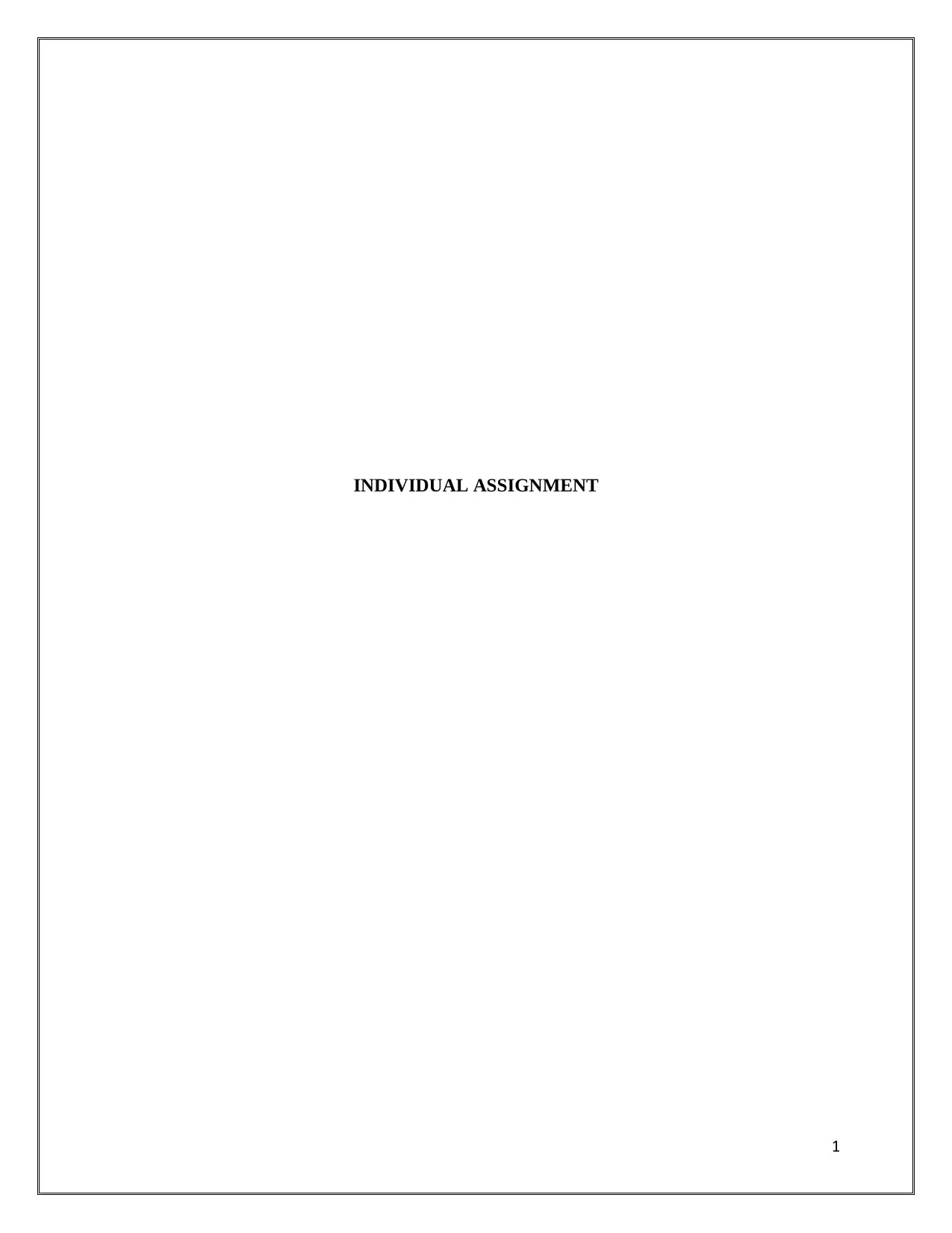
INDIVIDUAL ASSIGNMENT
1
1
Paraphrase This Document
Need a fresh take? Get an instant paraphrase of this document with our AI Paraphraser
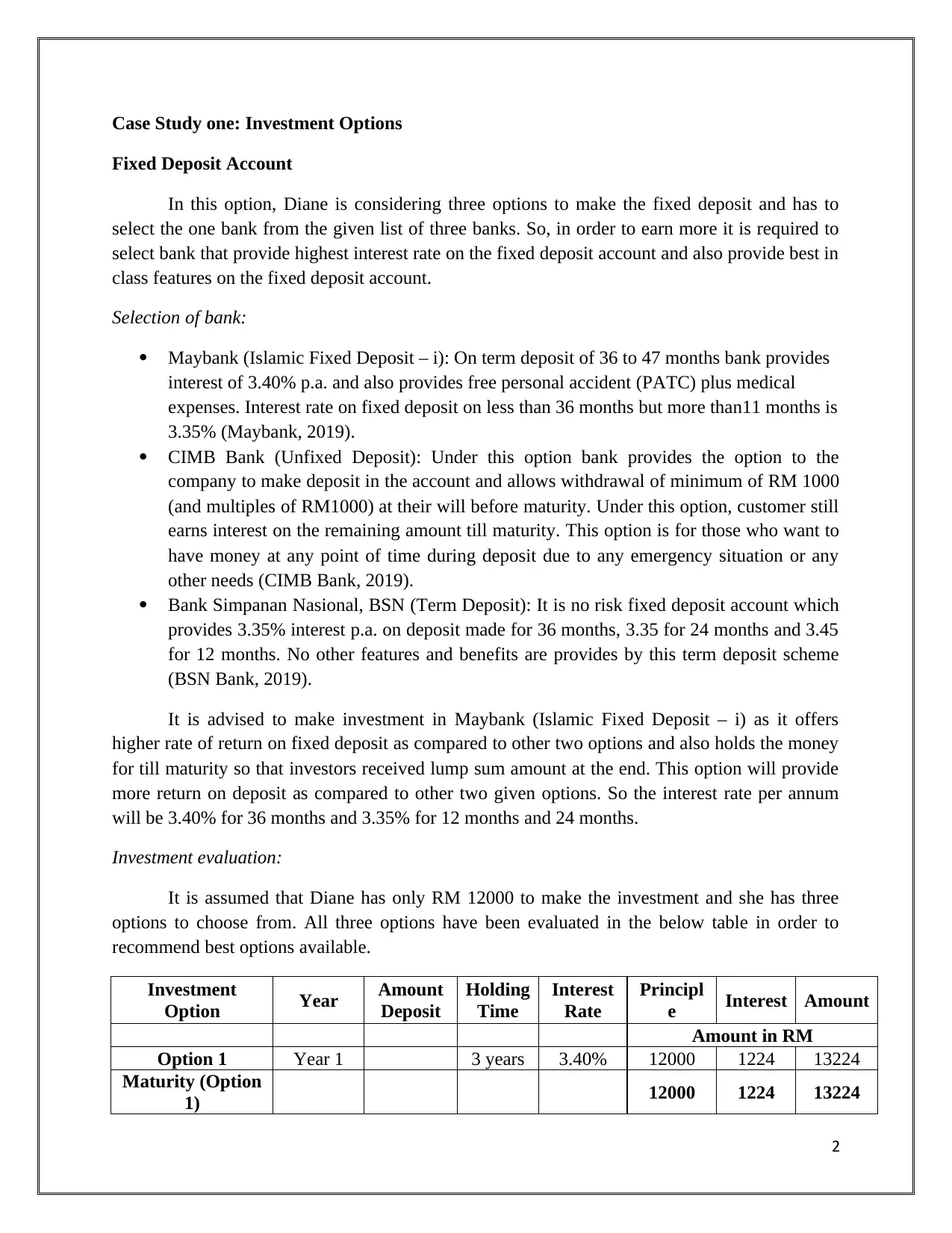
Case Study one: Investment Options
Fixed Deposit Account
In this option, Diane is considering three options to make the fixed deposit and has to
select the one bank from the given list of three banks. So, in order to earn more it is required to
select bank that provide highest interest rate on the fixed deposit account and also provide best in
class features on the fixed deposit account.
Selection of bank:
Maybank (Islamic Fixed Deposit – i): On term deposit of 36 to 47 months bank provides
interest of 3.40% p.a. and also provides free personal accident (PATC) plus medical
expenses. Interest rate on fixed deposit on less than 36 months but more than11 months is
3.35% (Maybank, 2019).
CIMB Bank (Unfixed Deposit): Under this option bank provides the option to the
company to make deposit in the account and allows withdrawal of minimum of RM 1000
(and multiples of RM1000) at their will before maturity. Under this option, customer still
earns interest on the remaining amount till maturity. This option is for those who want to
have money at any point of time during deposit due to any emergency situation or any
other needs (CIMB Bank, 2019).
Bank Simpanan Nasional, BSN (Term Deposit): It is no risk fixed deposit account which
provides 3.35% interest p.a. on deposit made for 36 months, 3.35 for 24 months and 3.45
for 12 months. No other features and benefits are provides by this term deposit scheme
(BSN Bank, 2019).
It is advised to make investment in Maybank (Islamic Fixed Deposit – i) as it offers
higher rate of return on fixed deposit as compared to other two options and also holds the money
for till maturity so that investors received lump sum amount at the end. This option will provide
more return on deposit as compared to other two given options. So the interest rate per annum
will be 3.40% for 36 months and 3.35% for 12 months and 24 months.
Investment evaluation:
It is assumed that Diane has only RM 12000 to make the investment and she has three
options to choose from. All three options have been evaluated in the below table in order to
recommend best options available.
Investment
Option Year Amount
Deposit
Holding
Time
Interest
Rate
Principl
e Interest Amount
Amount in RM
Option 1 Year 1 3 years 3.40% 12000 1224 13224
Maturity (Option
1) 12000 1224 13224
2
Fixed Deposit Account
In this option, Diane is considering three options to make the fixed deposit and has to
select the one bank from the given list of three banks. So, in order to earn more it is required to
select bank that provide highest interest rate on the fixed deposit account and also provide best in
class features on the fixed deposit account.
Selection of bank:
Maybank (Islamic Fixed Deposit – i): On term deposit of 36 to 47 months bank provides
interest of 3.40% p.a. and also provides free personal accident (PATC) plus medical
expenses. Interest rate on fixed deposit on less than 36 months but more than11 months is
3.35% (Maybank, 2019).
CIMB Bank (Unfixed Deposit): Under this option bank provides the option to the
company to make deposit in the account and allows withdrawal of minimum of RM 1000
(and multiples of RM1000) at their will before maturity. Under this option, customer still
earns interest on the remaining amount till maturity. This option is for those who want to
have money at any point of time during deposit due to any emergency situation or any
other needs (CIMB Bank, 2019).
Bank Simpanan Nasional, BSN (Term Deposit): It is no risk fixed deposit account which
provides 3.35% interest p.a. on deposit made for 36 months, 3.35 for 24 months and 3.45
for 12 months. No other features and benefits are provides by this term deposit scheme
(BSN Bank, 2019).
It is advised to make investment in Maybank (Islamic Fixed Deposit – i) as it offers
higher rate of return on fixed deposit as compared to other two options and also holds the money
for till maturity so that investors received lump sum amount at the end. This option will provide
more return on deposit as compared to other two given options. So the interest rate per annum
will be 3.40% for 36 months and 3.35% for 12 months and 24 months.
Investment evaluation:
It is assumed that Diane has only RM 12000 to make the investment and she has three
options to choose from. All three options have been evaluated in the below table in order to
recommend best options available.
Investment
Option Year Amount
Deposit
Holding
Time
Interest
Rate
Principl
e Interest Amount
Amount in RM
Option 1 Year 1 3 years 3.40% 12000 1224 13224
Maturity (Option
1) 12000 1224 13224
2
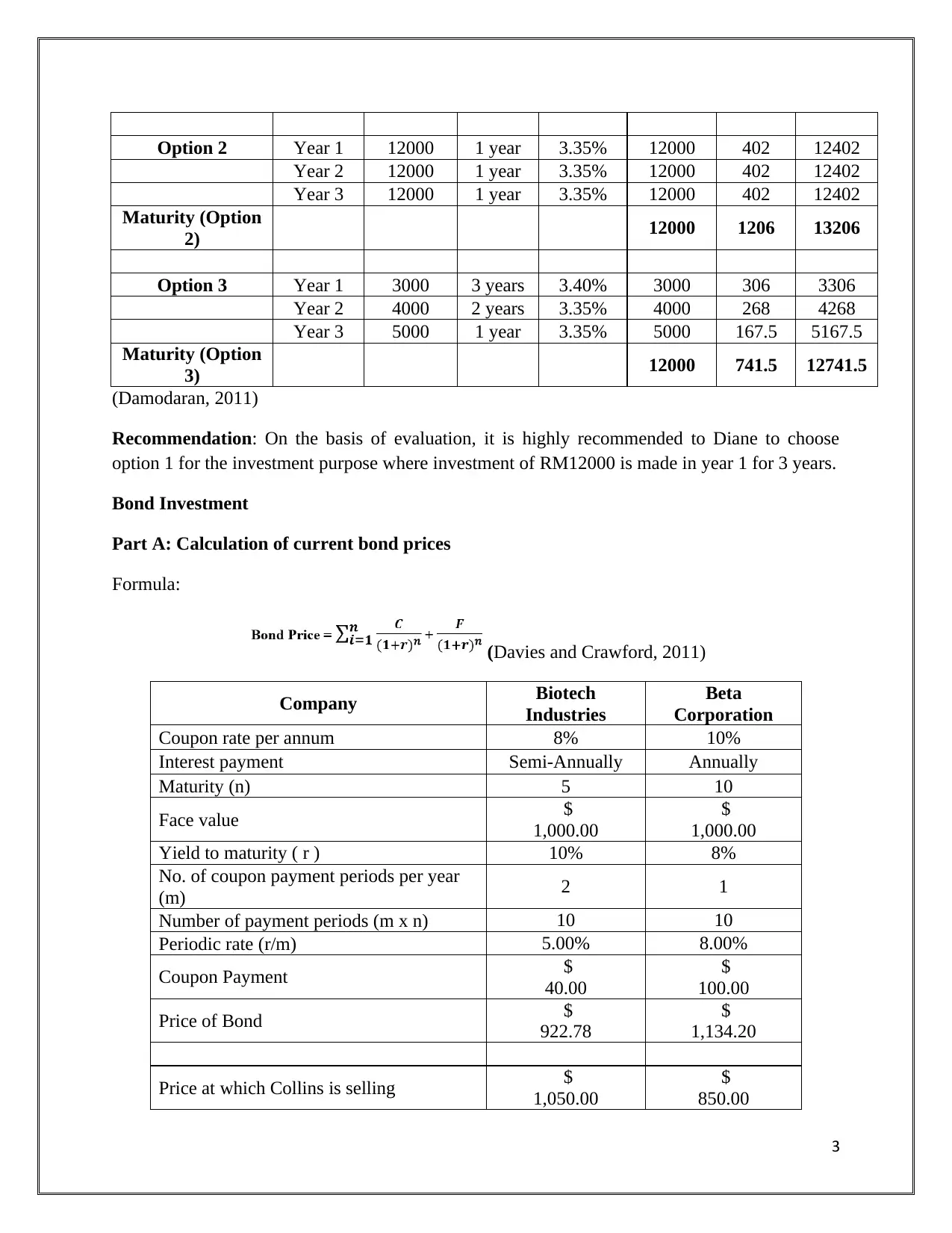
Option 2 Year 1 12000 1 year 3.35% 12000 402 12402
Year 2 12000 1 year 3.35% 12000 402 12402
Year 3 12000 1 year 3.35% 12000 402 12402
Maturity (Option
2) 12000 1206 13206
Option 3 Year 1 3000 3 years 3.40% 3000 306 3306
Year 2 4000 2 years 3.35% 4000 268 4268
Year 3 5000 1 year 3.35% 5000 167.5 5167.5
Maturity (Option
3) 12000 741.5 12741.5
(Damodaran, 2011)
Recommendation: On the basis of evaluation, it is highly recommended to Diane to choose
option 1 for the investment purpose where investment of RM12000 is made in year 1 for 3 years.
Bond Investment
Part A: Calculation of current bond prices
Formula:
(Davies and Crawford, 2011)
Company Biotech
Industries
Beta
Corporation
Coupon rate per annum 8% 10%
Interest payment Semi-Annually Annually
Maturity (n) 5 10
Face value $
1,000.00
$
1,000.00
Yield to maturity ( r ) 10% 8%
No. of coupon payment periods per year
(m) 2 1
Number of payment periods (m x n) 10 10
Periodic rate (r/m) 5.00% 8.00%
Coupon Payment $
40.00
$
100.00
Price of Bond $
922.78
$
1,134.20
Price at which Collins is selling $
1,050.00
$
850.00
3
Year 2 12000 1 year 3.35% 12000 402 12402
Year 3 12000 1 year 3.35% 12000 402 12402
Maturity (Option
2) 12000 1206 13206
Option 3 Year 1 3000 3 years 3.40% 3000 306 3306
Year 2 4000 2 years 3.35% 4000 268 4268
Year 3 5000 1 year 3.35% 5000 167.5 5167.5
Maturity (Option
3) 12000 741.5 12741.5
(Damodaran, 2011)
Recommendation: On the basis of evaluation, it is highly recommended to Diane to choose
option 1 for the investment purpose where investment of RM12000 is made in year 1 for 3 years.
Bond Investment
Part A: Calculation of current bond prices
Formula:
(Davies and Crawford, 2011)
Company Biotech
Industries
Beta
Corporation
Coupon rate per annum 8% 10%
Interest payment Semi-Annually Annually
Maturity (n) 5 10
Face value $
1,000.00
$
1,000.00
Yield to maturity ( r ) 10% 8%
No. of coupon payment periods per year
(m) 2 1
Number of payment periods (m x n) 10 10
Periodic rate (r/m) 5.00% 8.00%
Coupon Payment $
40.00
$
100.00
Price of Bond $
922.78
$
1,134.20
Price at which Collins is selling $
1,050.00
$
850.00
3
⊘ This is a preview!⊘
Do you want full access?
Subscribe today to unlock all pages.

Trusted by 1+ million students worldwide
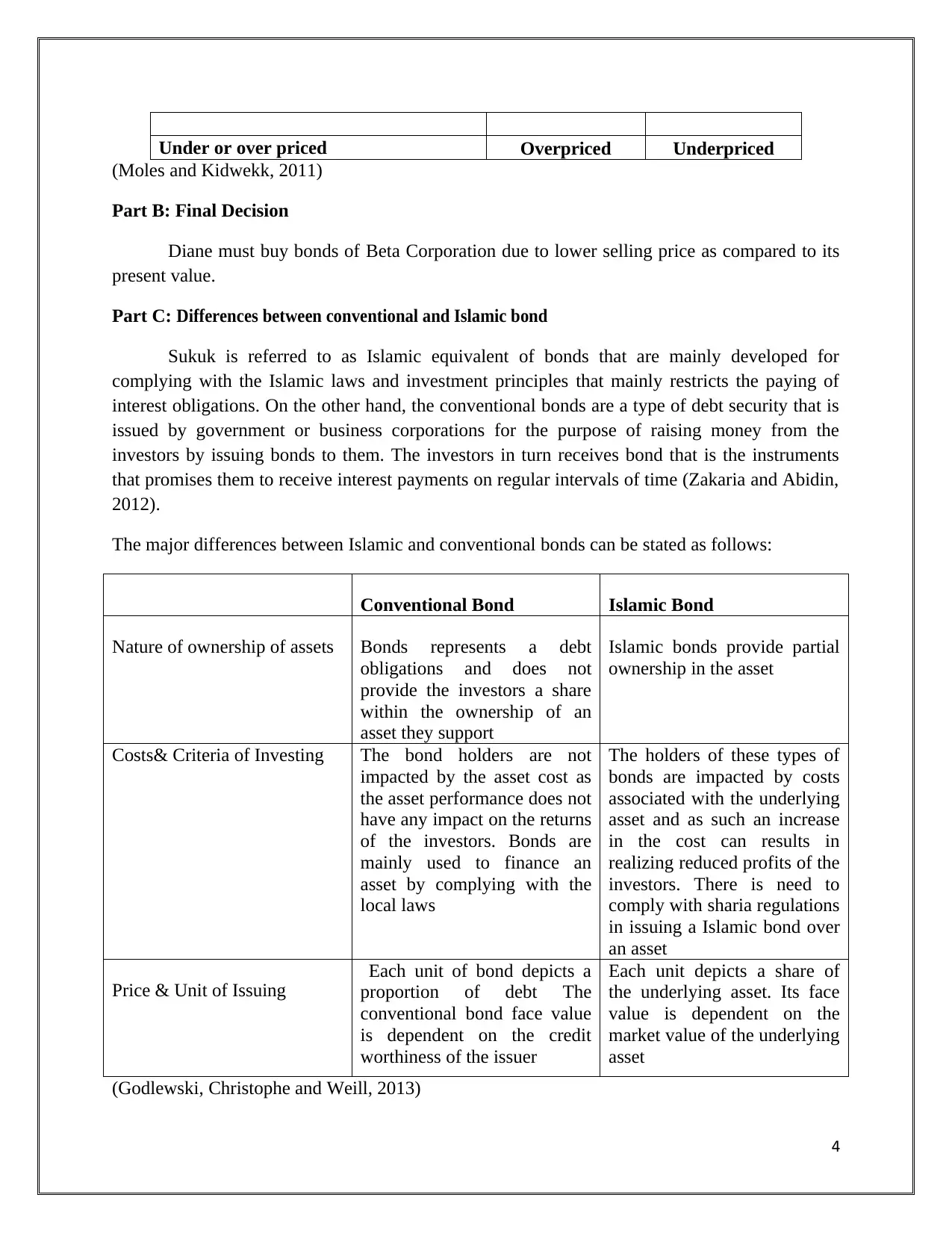
Under or over priced Overpriced Underpriced
(Moles and Kidwekk, 2011)
Part B: Final Decision
Diane must buy bonds of Beta Corporation due to lower selling price as compared to its
present value.
Part C: Differences between conventional and Islamic bond
Sukuk is referred to as Islamic equivalent of bonds that are mainly developed for
complying with the Islamic laws and investment principles that mainly restricts the paying of
interest obligations. On the other hand, the conventional bonds are a type of debt security that is
issued by government or business corporations for the purpose of raising money from the
investors by issuing bonds to them. The investors in turn receives bond that is the instruments
that promises them to receive interest payments on regular intervals of time (Zakaria and Abidin,
2012).
The major differences between Islamic and conventional bonds can be stated as follows:
Conventional Bond Islamic Bond
Nature of ownership of assets Bonds represents a debt
obligations and does not
provide the investors a share
within the ownership of an
asset they support
Islamic bonds provide partial
ownership in the asset
Costs& Criteria of Investing The bond holders are not
impacted by the asset cost as
the asset performance does not
have any impact on the returns
of the investors. Bonds are
mainly used to finance an
asset by complying with the
local laws
The holders of these types of
bonds are impacted by costs
associated with the underlying
asset and as such an increase
in the cost can results in
realizing reduced profits of the
investors. There is need to
comply with sharia regulations
in issuing a Islamic bond over
an asset
Price & Unit of Issuing
Each unit of bond depicts a
proportion of debt The
conventional bond face value
is dependent on the credit
worthiness of the issuer
Each unit depicts a share of
the underlying asset. Its face
value is dependent on the
market value of the underlying
asset
(Godlewski, Christophe and Weill, 2013)
4
(Moles and Kidwekk, 2011)
Part B: Final Decision
Diane must buy bonds of Beta Corporation due to lower selling price as compared to its
present value.
Part C: Differences between conventional and Islamic bond
Sukuk is referred to as Islamic equivalent of bonds that are mainly developed for
complying with the Islamic laws and investment principles that mainly restricts the paying of
interest obligations. On the other hand, the conventional bonds are a type of debt security that is
issued by government or business corporations for the purpose of raising money from the
investors by issuing bonds to them. The investors in turn receives bond that is the instruments
that promises them to receive interest payments on regular intervals of time (Zakaria and Abidin,
2012).
The major differences between Islamic and conventional bonds can be stated as follows:
Conventional Bond Islamic Bond
Nature of ownership of assets Bonds represents a debt
obligations and does not
provide the investors a share
within the ownership of an
asset they support
Islamic bonds provide partial
ownership in the asset
Costs& Criteria of Investing The bond holders are not
impacted by the asset cost as
the asset performance does not
have any impact on the returns
of the investors. Bonds are
mainly used to finance an
asset by complying with the
local laws
The holders of these types of
bonds are impacted by costs
associated with the underlying
asset and as such an increase
in the cost can results in
realizing reduced profits of the
investors. There is need to
comply with sharia regulations
in issuing a Islamic bond over
an asset
Price & Unit of Issuing
Each unit of bond depicts a
proportion of debt The
conventional bond face value
is dependent on the credit
worthiness of the issuer
Each unit depicts a share of
the underlying asset. Its face
value is dependent on the
market value of the underlying
asset
(Godlewski, Christophe and Weill, 2013)
4
Paraphrase This Document
Need a fresh take? Get an instant paraphrase of this document with our AI Paraphraser
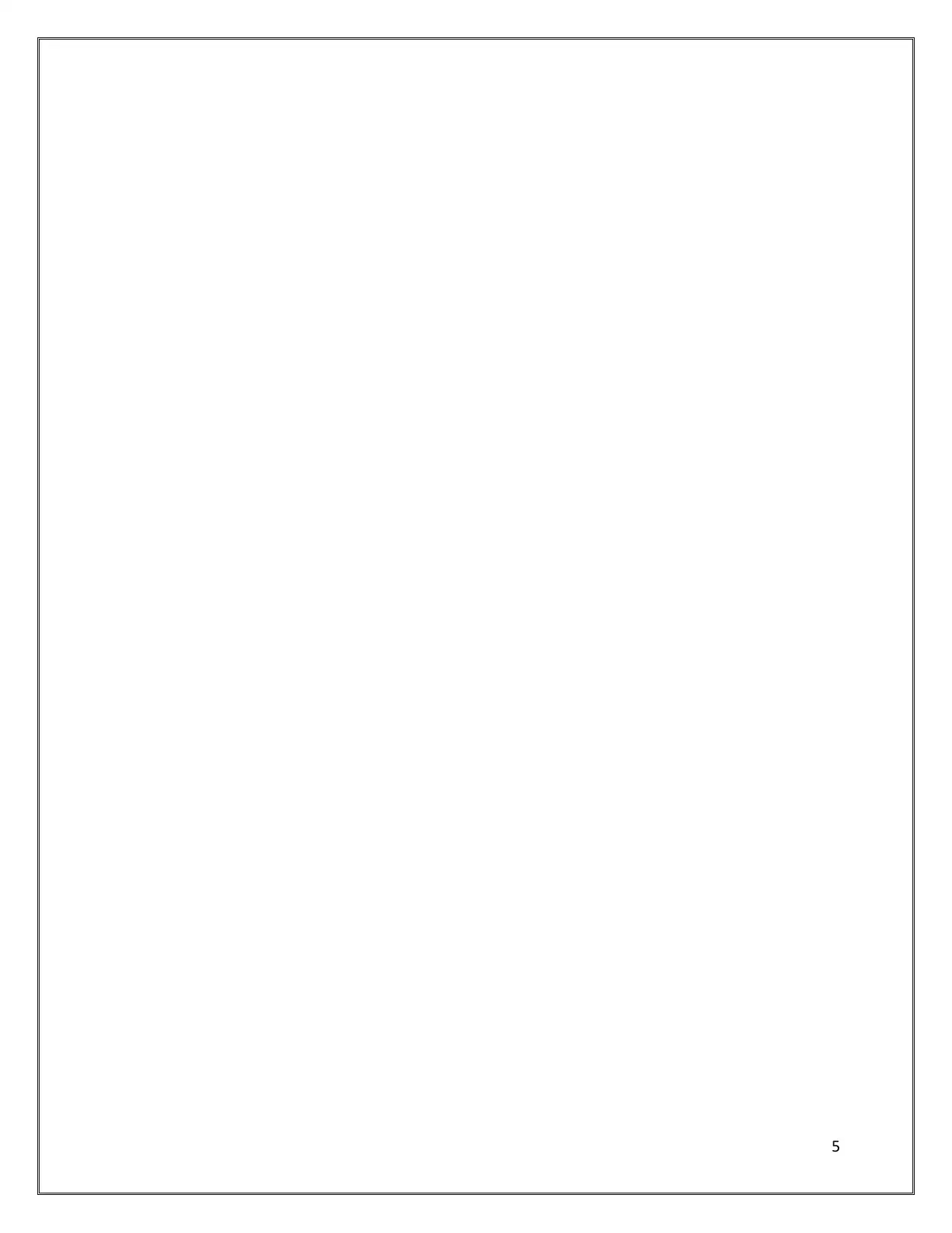
5
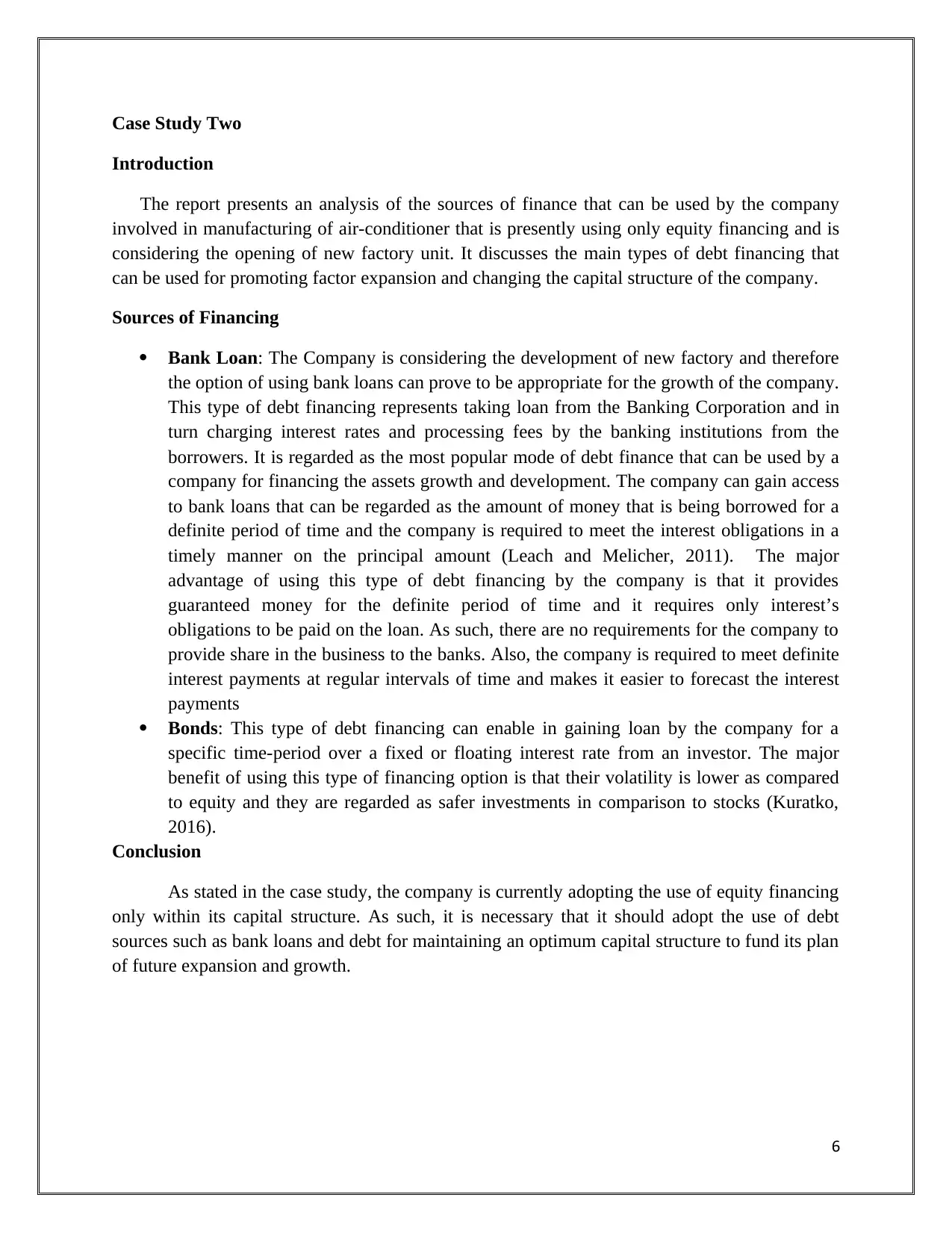
Case Study Two
Introduction
The report presents an analysis of the sources of finance that can be used by the company
involved in manufacturing of air-conditioner that is presently using only equity financing and is
considering the opening of new factory unit. It discusses the main types of debt financing that
can be used for promoting factor expansion and changing the capital structure of the company.
Sources of Financing
Bank Loan: The Company is considering the development of new factory and therefore
the option of using bank loans can prove to be appropriate for the growth of the company.
This type of debt financing represents taking loan from the Banking Corporation and in
turn charging interest rates and processing fees by the banking institutions from the
borrowers. It is regarded as the most popular mode of debt finance that can be used by a
company for financing the assets growth and development. The company can gain access
to bank loans that can be regarded as the amount of money that is being borrowed for a
definite period of time and the company is required to meet the interest obligations in a
timely manner on the principal amount (Leach and Melicher, 2011). The major
advantage of using this type of debt financing by the company is that it provides
guaranteed money for the definite period of time and it requires only interest’s
obligations to be paid on the loan. As such, there are no requirements for the company to
provide share in the business to the banks. Also, the company is required to meet definite
interest payments at regular intervals of time and makes it easier to forecast the interest
payments
Bonds: This type of debt financing can enable in gaining loan by the company for a
specific time-period over a fixed or floating interest rate from an investor. The major
benefit of using this type of financing option is that their volatility is lower as compared
to equity and they are regarded as safer investments in comparison to stocks (Kuratko,
2016).
Conclusion
As stated in the case study, the company is currently adopting the use of equity financing
only within its capital structure. As such, it is necessary that it should adopt the use of debt
sources such as bank loans and debt for maintaining an optimum capital structure to fund its plan
of future expansion and growth.
6
Introduction
The report presents an analysis of the sources of finance that can be used by the company
involved in manufacturing of air-conditioner that is presently using only equity financing and is
considering the opening of new factory unit. It discusses the main types of debt financing that
can be used for promoting factor expansion and changing the capital structure of the company.
Sources of Financing
Bank Loan: The Company is considering the development of new factory and therefore
the option of using bank loans can prove to be appropriate for the growth of the company.
This type of debt financing represents taking loan from the Banking Corporation and in
turn charging interest rates and processing fees by the banking institutions from the
borrowers. It is regarded as the most popular mode of debt finance that can be used by a
company for financing the assets growth and development. The company can gain access
to bank loans that can be regarded as the amount of money that is being borrowed for a
definite period of time and the company is required to meet the interest obligations in a
timely manner on the principal amount (Leach and Melicher, 2011). The major
advantage of using this type of debt financing by the company is that it provides
guaranteed money for the definite period of time and it requires only interest’s
obligations to be paid on the loan. As such, there are no requirements for the company to
provide share in the business to the banks. Also, the company is required to meet definite
interest payments at regular intervals of time and makes it easier to forecast the interest
payments
Bonds: This type of debt financing can enable in gaining loan by the company for a
specific time-period over a fixed or floating interest rate from an investor. The major
benefit of using this type of financing option is that their volatility is lower as compared
to equity and they are regarded as safer investments in comparison to stocks (Kuratko,
2016).
Conclusion
As stated in the case study, the company is currently adopting the use of equity financing
only within its capital structure. As such, it is necessary that it should adopt the use of debt
sources such as bank loans and debt for maintaining an optimum capital structure to fund its plan
of future expansion and growth.
6
⊘ This is a preview!⊘
Do you want full access?
Subscribe today to unlock all pages.

Trusted by 1+ million students worldwide
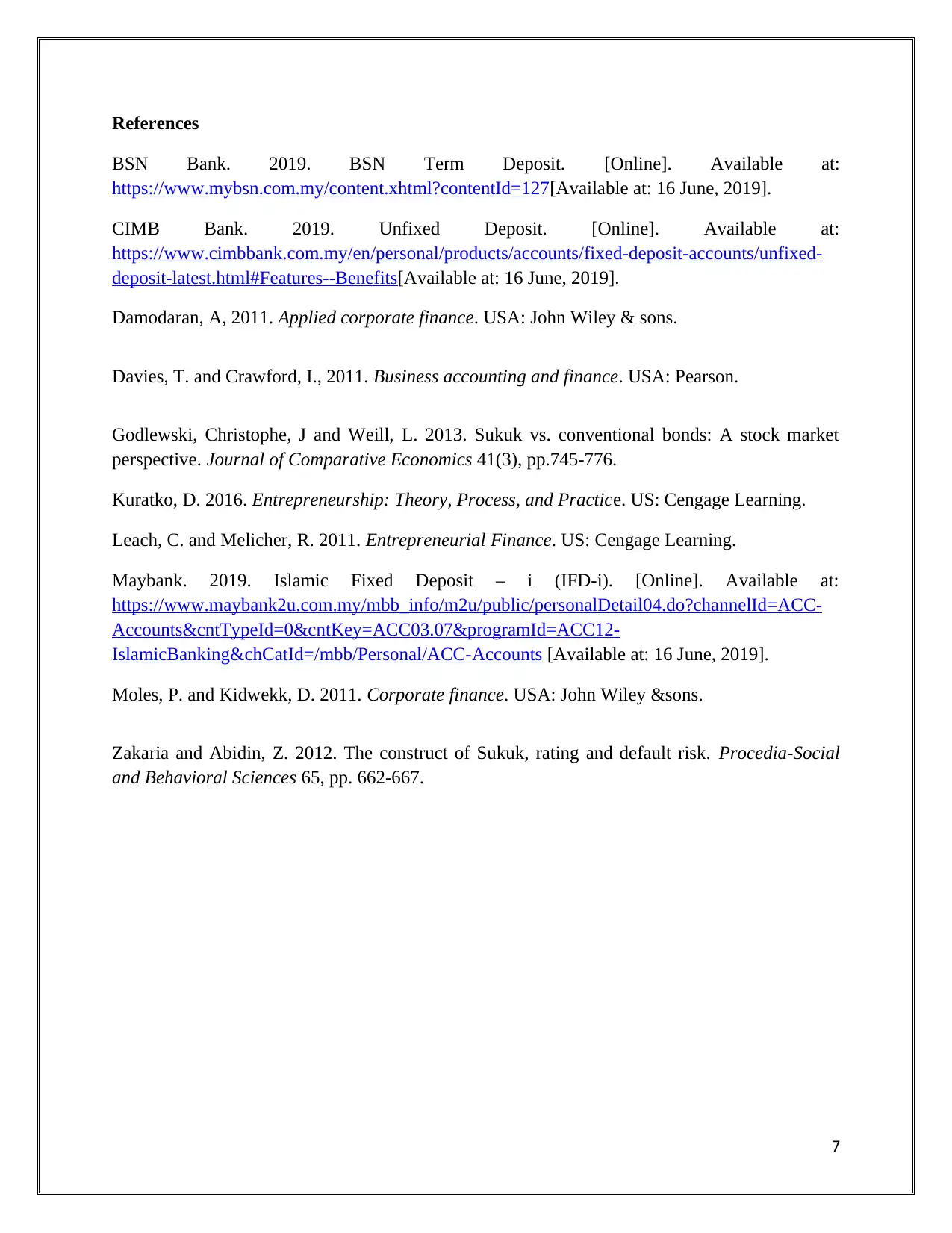
References
BSN Bank. 2019. BSN Term Deposit. [Online]. Available at:
https://www.mybsn.com.my/content.xhtml?contentId=127[Available at: 16 June, 2019].
CIMB Bank. 2019. Unfixed Deposit. [Online]. Available at:
https://www.cimbbank.com.my/en/personal/products/accounts/fixed-deposit-accounts/unfixed-
deposit-latest.html#Features--Benefits[Available at: 16 June, 2019].
Damodaran, A, 2011. Applied corporate finance. USA: John Wiley & sons.
Davies, T. and Crawford, I., 2011. Business accounting and finance. USA: Pearson.
Godlewski, Christophe, J and Weill, L. 2013. Sukuk vs. conventional bonds: A stock market
perspective. Journal of Comparative Economics 41(3), pp.745-776.
Kuratko, D. 2016. Entrepreneurship: Theory, Process, and Practice. US: Cengage Learning.
Leach, C. and Melicher, R. 2011. Entrepreneurial Finance. US: Cengage Learning.
Maybank. 2019. Islamic Fixed Deposit – i (IFD-i). [Online]. Available at:
https://www.maybank2u.com.my/mbb_info/m2u/public/personalDetail04.do?channelId=ACC-
Accounts&cntTypeId=0&cntKey=ACC03.07&programId=ACC12-
IslamicBanking&chCatId=/mbb/Personal/ACC-Accounts [Available at: 16 June, 2019].
Moles, P. and Kidwekk, D. 2011. Corporate finance. USA: John Wiley &sons.
Zakaria and Abidin, Z. 2012. The construct of Sukuk, rating and default risk. Procedia-Social
and Behavioral Sciences 65, pp. 662-667.
7
BSN Bank. 2019. BSN Term Deposit. [Online]. Available at:
https://www.mybsn.com.my/content.xhtml?contentId=127[Available at: 16 June, 2019].
CIMB Bank. 2019. Unfixed Deposit. [Online]. Available at:
https://www.cimbbank.com.my/en/personal/products/accounts/fixed-deposit-accounts/unfixed-
deposit-latest.html#Features--Benefits[Available at: 16 June, 2019].
Damodaran, A, 2011. Applied corporate finance. USA: John Wiley & sons.
Davies, T. and Crawford, I., 2011. Business accounting and finance. USA: Pearson.
Godlewski, Christophe, J and Weill, L. 2013. Sukuk vs. conventional bonds: A stock market
perspective. Journal of Comparative Economics 41(3), pp.745-776.
Kuratko, D. 2016. Entrepreneurship: Theory, Process, and Practice. US: Cengage Learning.
Leach, C. and Melicher, R. 2011. Entrepreneurial Finance. US: Cengage Learning.
Maybank. 2019. Islamic Fixed Deposit – i (IFD-i). [Online]. Available at:
https://www.maybank2u.com.my/mbb_info/m2u/public/personalDetail04.do?channelId=ACC-
Accounts&cntTypeId=0&cntKey=ACC03.07&programId=ACC12-
IslamicBanking&chCatId=/mbb/Personal/ACC-Accounts [Available at: 16 June, 2019].
Moles, P. and Kidwekk, D. 2011. Corporate finance. USA: John Wiley &sons.
Zakaria and Abidin, Z. 2012. The construct of Sukuk, rating and default risk. Procedia-Social
and Behavioral Sciences 65, pp. 662-667.
7
1 out of 7
Related Documents
Your All-in-One AI-Powered Toolkit for Academic Success.
+13062052269
info@desklib.com
Available 24*7 on WhatsApp / Email
![[object Object]](/_next/static/media/star-bottom.7253800d.svg)
Unlock your academic potential
Copyright © 2020–2025 A2Z Services. All Rights Reserved. Developed and managed by ZUCOL.




